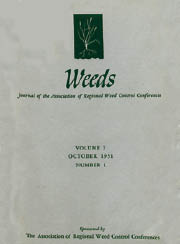No CrossRef data available.
Article contents
Effect of 2,4–D Sprays on the Growth of Young Sugar Cane
Published online by Cambridge University Press: 12 June 2017
Extract
Sugar cane appears to be suitable for the use of 2,4–D sprays for selective weed control. According to Young (1952) this is a regular commercial practice on some of the large plantations in Puerto Rico. The operators of certain plantations in Peru have found the application of 2,4–D to be economically practicable for broad-leaved weed control. Best and Gibbens (1951) have reported the value of 2,4–D sprays for sugar cane in Louisiana.
- Type
- Research Article
- Information
- Copyright
- Copyright © 1953 Weed Science Society of America
References
Literature Cited
Best, J. C., and Gibbens, R. T. Jr.
1951. Commercial use of chemicals in sugar cane for the control of Johnson grass. Southern Weed Conference Proc.
4: 40–41.Google Scholar
Nolla, J. A. B.
1950. Injury to sugar cane from 2,4–D. International Soc. Sugar Cane Tech. Proc. 1950. pp. 178–189.Google Scholar
van Dillewijn, C.
1952. Botany of sugar cane. The Chronica Botanica Co., Waltham, Mass. pp. 97–161.Google Scholar
van Overbeek, J.
1947. Use of synthetic hormones as weed killers in tropical agriculture. Econ. Bot.
1: 446–458.CrossRefGoogle Scholar
Young, P. D.
1952. (Personal correspondence) Central Aguirre Sugar Company, Aguirre, Puerto Rico.Google Scholar


